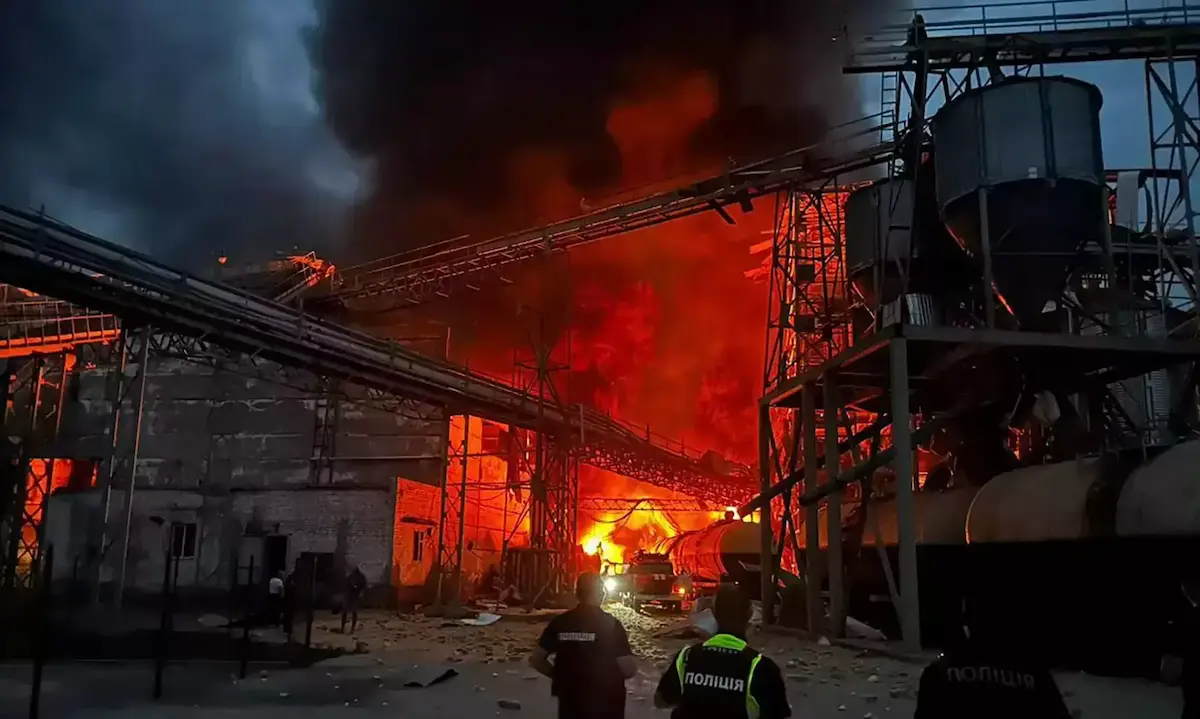
Ukraine hits Russia’s top refinery, sparking fuel crisis and export bans
Ukraine Strikes Russia’s Largest Refinery Sparks Global Fuel Shock-India at the Crossroads – In a dramatic escalation of the Russia-Ukraine conflict, Ukrainian drones have struck Russia’s largest oil refinery, triggering a massive fire and threatening global fuel supplies. As Moscow halts petrol exports to manage domestic shortages, countries like India heavily reliant on Russian crude face tough decisions.
The Strike That Shook the Energy World
On September 13, 2025, Ukraine launched a high-impact drone attack on the Kirishi oil refinery in Russia’s Leningrad region. This facility, operated by Surgutneftegas, refines around 355,000 barrels of crude oil per day, making it one of Russia’s top two refineries.
According to Ukraine’s military command, the refinery was targeted because it fuels Russia’s war machine. The attack caused multiple explosions and a large fire, visible in satellite images and videos shared online. Russian officials confirmed that three drones were shot down, but debris ignited the blaze. Fortunately, no casualties were reported.
This strike is part of a broader Ukrainian strategy: disrupt Russia’s energy infrastructure to weaken its military capabilities. Over the past 45 days, Ukraine has hit 12 refineries, affecting 42% of Russia’s refining capacity.
Ukraine Strikes, Fuel Crisis in Russia: Empty Pumps and Export Bans
The consequences of these attacks are already visible across Russia. Petrol stations in several regions have run dry, with long queues of vehicles and rationing measures in place. In response, Moscow has taken drastic steps:
- Complete ban on petrol exports until September 30
- Partial restrictions on traders and intermediaries until October 31
- Increased crude exports to international markets to offset refinery losses
Russia, the world’s second-largest oil exporter, is now struggling to meet domestic fuel demand. This internal crisis could ripple across global markets, especially in countries that depend on Russian oil for affordability and supply stability.
India’s Dilemma: Opportunity or Risk?
India, the third-largest oil consumer globally, imports a significant portion of its crude from Russia. The Kirishi attack and Russia’s export restrictions raise urgent questions: Will India face a fuel shortage? Will prices rise? What are the alternatives?
Interestingly, Indian refiners have already begun adapting. According to recent reports:
- Reliance, Nayara, IOCL, BPCL, and HPCL have increased Russian oil procurement, taking advantage of discounted Urals crude, priced $5–$6 below Brent.
- Reliance Industries alone could gain $500 million in annual EBITDA from these deals, boosting refining margins and retail growth.
- India’s petrol demand has grown 7% year-on-year, while diesel cracks have widened due to global supply disruptions.
Despite the crisis, India is strategically positioned to benefit, at least in the short term. By securing discounted Russian crude, Indian refiners are maintaining throughput and expanding exports to Europe, Africa, and Singapore.
However, this opportunity comes with risks:
- Geopolitical pressure from the U.S. and NATO to reduce Russian oil imports
- Volatility in supply chains if Russia tightens exports further
- Ethical concerns about buying oil from a country under heavy sanctions
India must now balance economic advantage with strategic caution.
Global Impact and India’s Next Steps
The Kirishi strike is more than a military event—it’s a global energy shock. It exposes vulnerabilities in oil infrastructure and highlights how modern warfare can disrupt civilian economies.
For India, the path forward may include:
- Diversifying oil sources: Increasing imports from the Middle East, Africa, and Latin America to reduce dependence on Russia.
- Boosting domestic production: Encouraging ONGC and other players to ramp up output and invest in refining capacity.
- Strategic reserves: Strengthening India’s petroleum reserve system to buffer against future shocks.
- Green transition: Accelerating investments in renewable energy to reduce long-term reliance on fossil fuels.
India’s policymakers must also prepare for price volatility, currency fluctuations, and supply chain disruptions. The government may need to subsidize fuel costs, adjust excise duties, or regulate retail margins to protect consumers.
At the diplomatic level, India must navigate a complex landscape. While maintaining ties with Russia, it must also reassure Western allies of its commitment to peace and stability.
Final Thought
Ukraine’s strike on Russia largest refinery is a turning point not just in the war, but in global energy politics. As fuel shortages loom and exports halt, India stands at a crossroads. Will it seize the moment to lead with strategy and resilience, or get caught in the crosswinds of conflict?
Also read: Ukraine Drone Offensive: Over 40 Russian Warplanes, Nuclear Bombers Destroyed in Deep Strike
Stay informed with the latest news and updates – only on Rapido Updates.